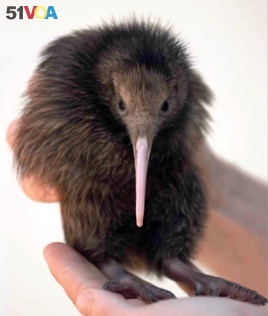10 December, 2017
News about endangered species often worries people. But on December 5, the International Union for the Conservation of Nature, or IUCN, had some good news. In publishing its yearly "Red List" of endangered species it noted some success for two kinds of New Zealand birds. The IUCN said the Okarito kiwi and the Northern Brown kiwi are now in less danger of disappearing from existence than in the past.
Key to helping the kiwis
The IUCN reports that New Zealand is reducing the populations of animals that kill and hunt the birds. The animals include stoats and cats.

In this Sept. 26, 1997, file photo, a handler holds Tuatahi, a 3-week-old Kiwi bird, the first kiwi born at Sydney's Taronga Zoo for more than 26 years
The number of Okarito kiwi has risen from 160 in 1995 to as many as 450 now, the IUCN said. It reported a rise in Northern Brown kiwi numbers also.
The IUCN is made up of government and non-government experts. Its studies help guide conservation policies. The Red List identifies which local species are at risk of disappearing from Earth.
Two species are new to the IUCN endangered list. The Irrawaddy dolphin and the finless porpoise travel along the coastlines of Southeast Asia. The Red List report says these sea animals get trapped in fishing nets and are harmed by other human activities as well.
The use of gillnets is among the fishing methods harmful to these species. The nets are used on the Mekong River and in other major waterways. They hang across waterways and entrap everything in the path.
Researchers have counted for the Red List about 91,500 of almost 1.9 million described species. Of these, 25,821 are threatened, 866 no longer exist and 69 others no longer exist in the wild. The IUCN describes 11,783 species as vulnerable, 8,455 as endangered and 5,583 as critically endangered.
Australia's Western Ringtail possum has moved from vulnerable to critically endangered on the Red List. The IUCN said its population dropped by 80 percent over the past ten years.
Possum now in danger
The Western Ringtail possum was once widespread in peppermint and eucalyptus forests. Now the animal has only a few disconnected places to live. High temperatures, which sicken the species, are becoming increasingly common where it lives.
The IUCN announced its findings in Tokyo. The Toyota automobile company helps pay for IUCN studies. The group warned of habitat loss and other dangers for some newly studied Japanese native species of lizards and snakes.
I'm Jill Robbins.
Dr. Jill Robbins adapted this story for Learning English based on an Associated Press story. Catherine Kelly Weaver was the editor.
_____________________________________________________________
Words in This Story
endangered - adj. used to describe a type of animal or plant that has become very rare and that could die out completely
species - n. a group of animals or plants that are similar and can produce young animals or plants
conservation - n. the protection of animals, plants, and natural resource
stoat – n. a small animal that has a long body and brown fur that turns white in winter
gillnet - n. a fishing net that is hung vertically so that fish get trapped in it by their gills.
habitat - n. the place or type of place where a plant or animal naturally or normally lives or grows
vulnerable - adj. open to attack, harm, or damage
What are some endangered species near where you live? Are you doing anything to help them? Write to us in the Comments Section.